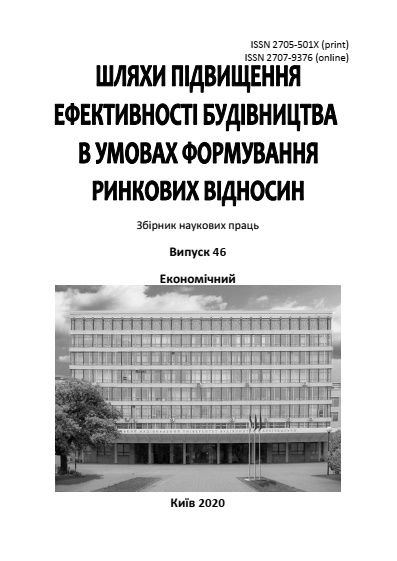Evaluation of business activity of a construction firm
DOI:
https://doi.org/10.32347/2707-501x.2020.46.163-175Keywords:
quantitative analysis, turnover, production cycle, accounts payable, liquidity of the enterprise, net profit, production efficiency, economic indicatorsAbstract
The assessment of current production activities is carried out on the example of specialized construction and installation management with the help of turnover indicators as well as the level of efficiency of use of own and borrowed funds by the enterprise was determined.
Indicators of this group characterize the results and efficiency of the current main activity of the enterprise, such analysis can be carried out both at the qualitative level and with the help of quantitative criteria.
The main ones are production indicators, return on assets and turnover indicators. These indicators are of great importance for assessing the financial condition of the enterprise, because the speed of turnover, i.e. the speed of their conversion into cash, directly affects the solvency. The results of the calculation of the rate of return indicate that this fact (decrease in the turnover of fixed assets) may be associated with aging and wear of production equipment, i.e. we can say that the technical level of fixed assets of the object is low.
The coefficient of sustainability of economic growth shows the average rate at which the company can develop further, without changing the already established relationship between different sources of funding. Summarizing the comparative data, we can say that if the management of the enterprise intends to increase its production capacity in order to increase production, it is necessary to change the financial policy. The results of calculations allow to show that at the analyzed enterprise there was a significant increase in the full production cycle and turnover as a whole. The duration of the operating cycle increased by more than 1.2 times and the duration of the financial cycle by almost 2 times. This was negatively affected by the factor of a significant slowdown in the turnover of inventories. Increasing the full production cycle in the future may cause negative trends in the enterprise as a whole, because this factor will primarily affect the amount of profit, which will affect the efficiency of production. The company activities to reduce the amount of net profit was influenced primarily by the acquisition of inventories, low-value perishable items and fixed assets, as well as repayment of accounts payable and payment of penalties.
The period of turnover of the most liquid assets during the year varied from 0.04 to 17.5 days. The average chronological value in the period of saving money in the accounts of the enterprise was 7.5 days. This fact indicates that the company, despite the apparent well-being, is experiencing a serious shortage of funds. They were enough for a little over a week. Thus, with the help of analysis of economic indicators, you can describe the general condition of the company and the possibilities of its operation and development
References
Шаповалова І.С. Социогенетичний підхід у вивченні організаційної культури. Наукові відомості БелГУ. 2009. № 5. С. 159-167.
Новіков О.В. Основи функціональної теорії еволюції економічних систем // Питання економіки і права. 2011. № 7. С. 141-144.
Астафєв Б.А. Геном і закони Світу - основа організації життя майбутнього людства [Електрон. ресурс] - Режим доступу: http://www.raen-education.webhost.ru/plan_3_2.htm
Модель досконалості EFQM. EFQM. - Брюссель. – 2011. Офіційний сайт EFQM. - Режим доступ: http://www.efqm.org/the-efqm-excellence-model
Калита П.Я. Нарис про геномі успішності організацій і держави. Частина 1. Стандартизація, сертифікація, якість. 2014. № 1.
Калита П.Я. Стабільність якості продукції. Оціночні показники. Стандарти і якість. 1991. № 2.
Калита П.Я. Від процесів управління якістю до цілісної технології безперервного вдосконалення організації. Стандарти і якість. 2001. № 1.
Калита П.Я. Системний технологічний менеджмент. Світ якості України. 2004. № 2.
Калита П.Я. Інженерна технологія забезпечення якості продукції по зворотним звязкам. Стандарти і якість. 1989. № 5.
Бачевський Б.Є., Решетняк Є.А. Діагностика та оцінка потенціалу підприємства. Маркетинг: теорія і практика. Вип. № 13, 2007. 280 с.
Бачевський Б.Є., Перепелюкова О.В. Механізм реалізації потенціалу підприємства: Регіональний зб. наук. пр. з економіки.2007, Вип. 2 (23), C. 262 - 265.
Гавва В.Н., Божко Е.А. Потенціал підприємства: формування та оцінювання: навчальний посібник. К.: Центр навчальної літератури, 2011. 224 с.
Богданов О.О. Загальна організаційна наука – тектологія Додатки. Ч. 1. М. - Л., 1925. С. 110.
Пригожин А.И. Методы развития организаций. М. Знание 2007. 567 с.
Савенко В.І., Доценко С.І., Савенко С.С. та ін.. Конкурентоздатність будівельної організації– основа виживання економіки: монографія. УАН Центр навчальної літер. К. 2017.128с.
Савенко С.С. , В.І. Савенко, Ю.В. Орлик та ін.. Аналіз фінансового стану будівельної організації: монографія: К. УАН Центр навч. літер. К. 2017 95с.
Ізмайлова К.В. Фінансовий аналіз. [2-ге вид. пер. і допов.] К.:МАУП, 2001. 83 с.
Измайлова К.В. Финансовый анализ. М.: ЦУЛ, 2000. 200 с.
Ізмайлова К.В. Финансовый анализ субъекта хозяйствования: [cправочное пособие]. Минск : Выш. шк., 1997. 309 с.
Ізмайлова К.В. Фінанси підприємств: консп. лекцій. Київ: КНУБА. 2020. 156 с.
Downloads
Published
How to Cite
Issue
Section
License

This work is licensed under a Creative Commons Attribution 4.0 International License.
Authors who publish with this journal agree to the following terms:
- Authors retain copyright and grant the journal right of first publication with the work simultaneously licensed under a Creative Commons Attribution License that allows others to share the work with an acknowledgement of the work's authorship and initial publication in this journal.
- Authors are able to enter into separate, additional contractual arrangements for the non-exclusive distribution of the journal's published version of the work (e.g., post it to an institutional repository or publish it in a book), with an acknowledgement of its initial publication in this journal.
- Authors are permitted and encouraged to post their work online (e.g., in institutional repositories or on their website) prior to and during the submission process, as it can lead to productive exchanges, as well as earlier and greater citation of published work (See The Effect of Open Access).

